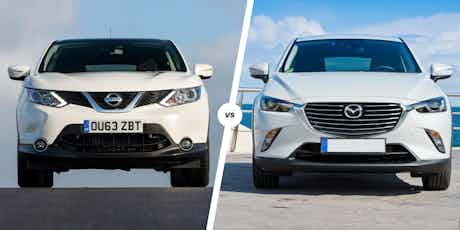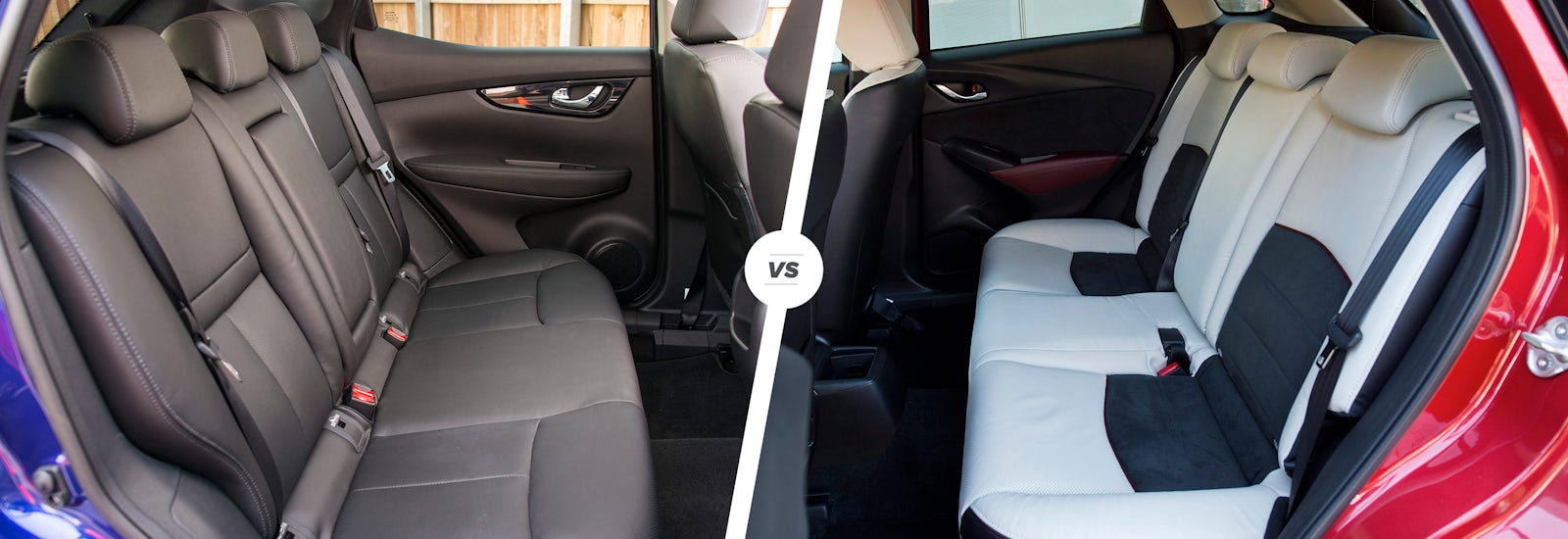Nissan Qashqai vs Mazda CX-3 – crossover contender comparison
March 19, 2015 by carwow staff

Nissan pulled the rabbit out the hat in 2006 when it launched the Qashqai crossover. It wasn’t the first car in the segment by any means but mixing a car-like drive and fuel economy with an off-roader’s driving position and space made it an overnight sales success.
It was a bit of a surprise when it was replaced in 2013, seemingly still at the top of its game, but Nissan had done its homework and improved every little bit to make for one of the highest rated cars of any kind on sale today.
Mazda is one of the few brands to offer a genuine competitor to the Qashqai in the shape of its CX-5 but, when we compared them in December 2014, we found the significant price gap put them in two different classes. But Mazda has another trick up its sleeve with a new and slightly smaller version. Dubbed the CX-3, it’s a dinkier and cheaper crossover and could finally dethrone the teacher’s pet Nissan?

Styling
It’s tough to deny the Qashqai’s styling is a vast improvement over its forebear, which always looked a little soft and pudgy. The redesign has toughened it up a little, with a few more bulges and creases. The bulbous bonnet is a particular favourite of ours and the creases flow nicely down into the wider chrome Nissan “V” in the grille.
The rear haunches are nicely judged too, and they give way into a massive pair of notched tail lights sitting on the back end like a giant set of arrows, pointing you to the boot release.
You’ll not fail to notice the family similarity to the rest of the Mazda range with the CX-3. It’s really hard to pick out a favourite detail, but the line that starts at the very bottom centre of the grille and goes up and over the bonnet right down to the middle of the back door is high on the list.
Mazda’s seen fit to give the back of the roof a floating pillar-less arrangement, with the rearmost “D” pillars blacked out to give the effect of wraparound glass. There’s a hint of Mini Paceman there that might not be to all tastes – but it hasn’t stopped the Mini selling well.

Interior
Everything in the Qashqai is suitably chunky and positioned in just about the right – or at least most reasonable – place. Materials are largely of a high quality as long as you avoid the entry level Visia trim and there’s a nice mix of technology on offer. We’re still big fans of the Around View Monitor which knits together the images from four cameras to give you a bird’s eye view of the car when manoeuvring.
The interior of the CX-3 is, unusually, identical to the much smaller 2 hatchback but it’s a pretty smart one. We love the asymmetrical vents on the dash, while the instrument binnacle is dominated by a single large dial that’s either the tachometer or the speedo, depending on trim. There’s a nice, large infotainment screen as standard, cutting down on some of the buttons, with a pretty nifty head-up display if you opt for a higher grade model.
Some of the plastics are said to be a little rough but Mazda, like Nissan, screws them together well.

Practicality
This is where the Qashqai is going to score better, because it’s simply the bigger car. The larger Mazda CX-5 is a little under 18cm longer than the Nissan, but the CX-3 is about 10cm shorter.
It immediately shows in boot space, where the Qashqai packs in 430 litres of stuff while the tiny CX-3 will only hold 350. That’s not an embarrassing amount – it’s as good as the average family hatchback – but the Qashqai wins out. There’s no official data on the Mazda’s seats-down space, but it’s not going to come too close to the 1,585-litre cavern in the Nissan.
When it comes to cabin room, the Qashqai is still out in front, because the Mazda’s B-segment hatch origins means there’s simply less room. You won’t exactly be crammed into either car, but the sloping rear rooflines of both combined with slightly higher-set rear seats – to allow the occupants a better view – may make it a bit claustrophobic for adults over long journeys.

Engines
There’s very little choice of engines in the CX-3, with a pair of petrols (118hp or 148hp) and a diesel (104hp), coming from their new ‘SkyActiv’ range. At the moment, the critics aren’t sold on the diesel option – the little 1.5-litre unit is refined and brisk at speed but lacks low speed torque. The diesel is available with optional four-wheel drive though, whereas the petrol engines are limited to one or the other – front-wheel drive in the lower power car, four-wheel drive in the more powerful one.
The petrol options are tried and tested now and you can expect pretty decent fuel economy – up and over 50mpg in the real world – even with 4WD or the optional automatic gearbox. The most powerful option should crack into the 8s range for a 0-60mph sprint, if that sort of thing is important to you.
There’s a much wider array in the Qashqai, with 110hp (1.5), 115hp (1.6) and 130hp (1.6) versions of the dCi diesel Nissan shares with Renault and 115hp (1.2) and 163hp (1.6) versions of the DiG-T turbocharged petrol engine.
Only the 1.6 dCi 130hp model is available with four-wheel drive, so if having extra traction in the sleet and snow is important to you, you’ll have to abandon any hopes of a petrol car. Still, the diesels are proven units and, in most frugal form, return up to 72mpg combined – though you’ll be lucky to see that in reality. If you do opt for the 163hp performance option, you’ll still be watching the CX-3 walk away from you in a traffic light grand prix.

Driving
Both cars trade on their car-like driving experience and in both cases they’re on the money, but they attack the brief from different angles.
In the Qashqai, it’s all about comfort and refinement. We’re some distance away from luxury car levels of serenity, but you will float along relatively cossetted from the typical road blemishes we see around. The penalty for this is a little softness to the driving experience itself but, if tackling the Silverstone GP circuit isn’t on your bucket list, the Qashqai more than suffices on the road.
Just like its big brother though, the CX-3 goes straight to the fun end of the segment. It’s a cracking little car with plenty of driver involvement and feedback. The Nissan doesn’t exactly wallow, but the Mazda is far more flat and composed in the bends and offers a sportier driving experience than pretty much any other crossover.
You’ll suffer a slightly firmer ride in the process and there’s a good chunk more road noise to remind you which is the less comfortable car as you roar down the motorway.

Value for money
You might laugh at this point because the CX-3 is obviously going to be by far the cheaper car, but you may want to stifle it for a moment. At entry level there is not even a thousand pounds in it – the Mazda’s £17,595 plays the Nissan’s £18,265.
The Mazda justifies this with a whole raft of kit right out of the box – every CX-3 ships with 16” alloy wheels, air-conditioning, cruise control, DAB radio, MZD-Connect allowing internet radio selection and a 7” colour touchscreen. Against a basic Qashqai Visia on steel wheels with an orange TFT screen, the CX-3 will look like a bargain.
Head up the range and you’ll find the Mazda tops out at a pretty alarming £24,695 – though, that’s with the four-wheel-drive system and optional automatic gearbox. That undercuts the equivalent Qashqai by about £2,500 and that’s broadly the tale up and down the specs – the Nissan can’t get close on purchase price.
Running costs ought to be broadly comparable, but we wouldn’t be surprised to see the Mazda’s big petrol engines get much closer to their official fuel economy figures than the Nissan’s smaller, turbocharged ones. Road tax will be roughly similar on each equivalent engine though and both pack a 3 year/60,000 mile warranty. While we expect the cars to depreciate similarly, the fact the Mazda is a little cheaper means it will lose a little less money in the long run.

Verdict
This will actually prove a genuinely hard choice. The Mazda has been pitched as a competitor for Nissan’s smaller Juke, but it’s a bigger, roomer and better quality car that will be cross-shopped by customers looking at the Qashqai.
Mazda seems to be holding most of the cards here, with the Qashqai’s saving graces being a much roomier cabin and a gentler ride. The first bite is with the eye though and the CX-3 knocks this one out of the park – it’s going to be difficult to settle for the Qashqai once you’ve seen both side by side.
Ultimately, if you need lots of space and value peace and refinement, the Qashqai is a truly excellent car. If you want a stylish crossover that’s fantastic to drive and you don’t need quite as much space then the CX-3 is absolutely worth a look.

Which would you have?
Let us know in the comments section below which you’d like to see on your driveway, then check out our full reviews of the Qashqai and the CX-3. Don’t forget to take a look at our deals page for our latest discounts and our car configurator to see how much you could save on your next car.















